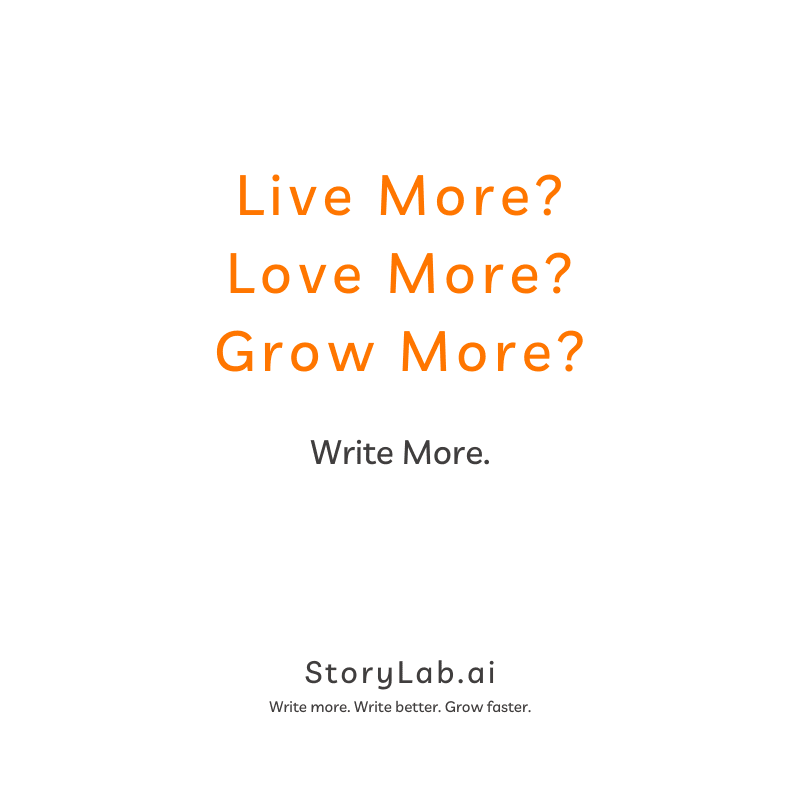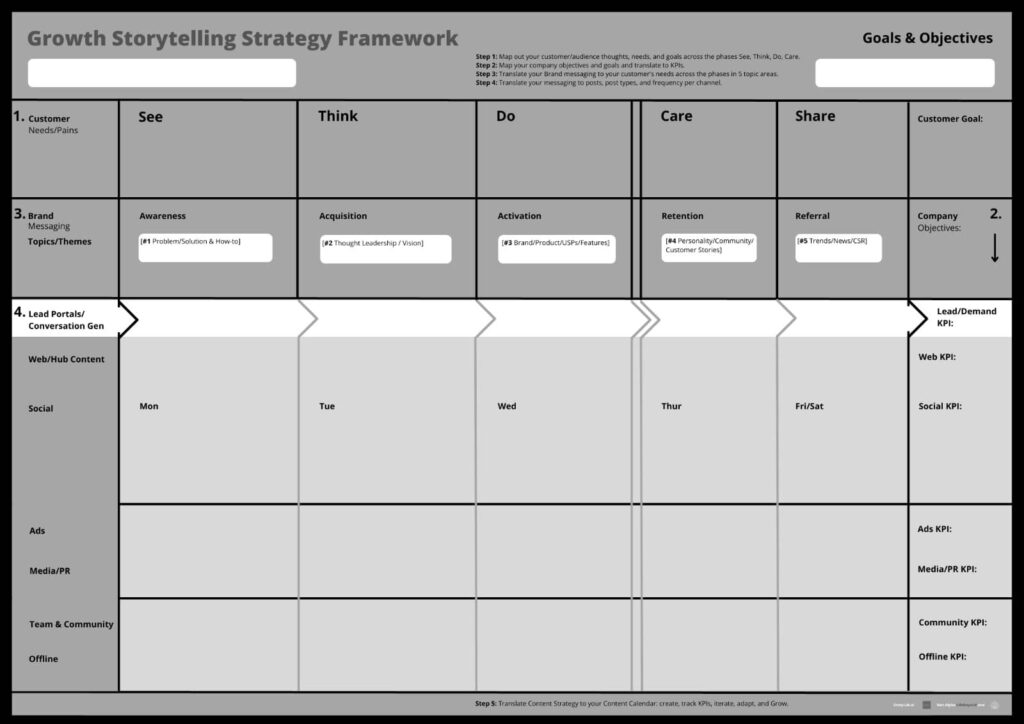How to Setup Your Content Marketing Strategy
How to Share your Stories Strategically to Reach Your Goals
“Strategy” sounds really complicated, doesn’t it? Well, it doesn’t have to be.
Here’s why having a basic strategy to your Storytelling is important, and how you can create your own content strategy in a few easy steps.
In this article
Why you need a content strategy
Once you’ve started writing, creating content and sharing it online, you want to make sure you’re not just shooting stories out randomly. You want to have a plan. If you’re creating content and publishing it, you have some sort of a goal. The point with a strategy is to make that goal a bit more explicit — and then to map out a plan for how to get there.
The term “Content Strategy” can sound a bit daunting, especially if you’re a beginner in online content creation or marketing. And even if you’ve got a little bit more experience — then you know exactly how complex and elaborate a content strategy can be. But it doesn’t have to be all that complicated.
I’ve got more than 10 years of experience in online writing and content marketing. I’ve seen strategies that are 60 pages long, and that don’t work too well — and I’ve seen ones that fit on one page and that are super-effective.
Here’s what a content strategy at its most basic actually is, and how to build your own in a few very basic steps.
First: the goal of having a strategy to your content

Write and share your stories to find the maximum positive impact for the other as well as yourself.
What you really want from your stories is for them to help you reach your goals, and for them to help your readers to reach their own. That means, that you want to have figured out:
- What your goals are.
- What your audience’s goals are.
- What the steps are to connecting your goals to those of your audience.
Getting from A to B, or from 1 to three in the above summary, is what your strategy is for. Your strategy is your roadmap for how you’re going to get from where you are now, to where you need to go.
How to create your own Content Strategy

This is how you build up a basic marketing or Storytelling strategy:
1. Identity and value proposition
Figure out who you are and what you have to offer. What is your Mission? What is your (personal or brand) vision for the world? What is it you or your organization know(s) more about than other people, are better at than other people and/or that people might want to learn from you about? Write these down. Come up with 1 to 3 topic areas to write about, for now.
2. Audience and needs
Figure out what it is that people you could help, actually need (with research and by talking to the actual people). Doing some keyword research is probably a good idea, here, too [read more about basic SEO and keyword research, here]. Figure out who your target audience actually is — this helps you create a better strategy and better content as well.
3. Connect your goals to those of your audience
Figure out how you can help the people in your audience, and what a reasonable goal is that you could achieve for yourself, with the help of content marketing. For example: could you help people with advice? Would that be in the form of free stories, or could you create an e-book? This is where it might be valuable to create (or revise) a basic value proposition, if you’re already at that stage. What product or service could you offer that actually solves your audience’s needs?
4. Make it measurable
Connect a few KPIs (Key Performance Indicators) to your goals. I advise you to keep track of no more than three main KPIs at a time. How many people will you reach? How many people will read your stories? If you’re selling something, how many customers will you serve in a given period of time?
Make sure the numbers are as concrete as possible, not too high but a reasonable challenge. And make sure you keep track of your results so you can change your plan whenever necessary.
5. Build your messaging
Build the messaging that conveys your understanding of what your audience needs, how you can help them and how it will benefit them (with the trinity of Need, Solution, Result). Read more about the Need, Solution, Result structure, here.
The Need, Solution, Result structure can be built into a single piece, but it can also form a basic structure for a storyline of three pieces — drawing your reader from a problem, to your solution, to proof of your solution, to a Call-to-Action.
Maybe the simplest content flow that you could have is three pieces that are linked together in this way, leading up to a (paid) offer.
Build your messaging strategy with the free Growth Storytelling Strategy Framework

The Growth Storytelling Strategy Framework is specifically designed to help you brainstorm and create your messaging super-structure, taking into account your brand identity and goals, and the knowledge you have about your customers and their goals.
6. Select the right channels
Consistently share where your audience listens and reads for the subject matter and type of story you’re sharing. What platforms are your audience or potential customers active on? Do your research, talk to people, and test the response you get on various channels.
7. Gather feedback
Consistently measure and track feedback from your audience and customers on your messaging. Specifically look at data that connects to the KPIs you listed in step four. Will you be tracking views? Shares? Link clicks?
Will you be tracking website pageviews or filled out contact forms, or both? Why?
Don’t forget to also gather qualitative feedback: talk to people. Ask them how they’re experiencing your content. Is it helpful? Is it relevant? What could you do to improve it?
8. Improve your storytelling and strategy
Continuously improve your story based on feedback and data from step 5: go back to step 1, and repeat. And that’s it.
What your content strategy does and doesn’t need to be
Your content strategy doesn’t have to be perfect. It just has to make sense. And preferably, you’ve talked to people in your audience to make sure you’re not basing it all on assumptions, but also partially on what the people actually need.
Also, your strategy doesn’t have to be worked out in a 50-page plan or 60-slide power point. It can be the answers to the above questions on a notepad or simple document.
Lastly, you don’t necessarily need to map out a content strategy for a whole year. It’s often even preferable to map it out for something like three or six months. That way, you set yourself up for evaluating what works and what doesn’t after your first few months of sticking to the plan have passed.
This will make your content strategy much more responsive to what the world outside is actually telling you, and therefore, all the more successful.
Finally: Content Marketing Success
A basic content strategy is what sets the advanced content creator or marketer apart from the complete beginner. And it is what helps you feel like you know what you’re doing, and what helps you always know what to focus on next. Be sure to implement it in your Inbound Marketing Strategy.
Additionally, it helps you know what piece of content you need to focus on next, which is incredibly important if you want to keep up the habit of creating and publishing content online.
Finally, a content strategy that has the monitoring of data and the collection of feedback built-in, is what sets apart the expert from the advanced content creator. Because this helps you continuously improve your content, the way you get it to your audience, and ultimately to improve your chances of reaching your content goals.
Happy writing!
Getting the most out of your Content Marketing Efforts
Having a Content Marketing Strategy is great as a standalone document but even more powerful sitting within a Growth Storytelling Framework accompanied by a couple more strategic and tactical documents like a Content Distribution Strategy, On-Page SEO Checklist, Strategic Storytelling Framework and more.
You can access it for free here. No signup is needed.
Go forth and create the best possible content and tell your best stories.
We will be here to support you however we can.

FAQ
What is a content marketing strategy?
A content marketing strategy is a plan for creating, publishing, and distributing valuable and relevant content to attract and engage a targeted audience, with the goal of driving profitable customer action.
How important is audience research in content marketing?
Audience research is crucial as it ensures the content resonates with the interests, needs, and problems of the target audience, increasing its effectiveness in engagement and conversion.
What role does SEO play in a content marketing strategy?
SEO helps in making content discoverable in search engines. It involves using relevant keywords, optimizing content structure, and ensuring high-quality, valuable content for better rankings.
How can businesses measure the success of their content marketing strategy?
Success can be measured through metrics like website traffic, engagement rates, lead generation, conversion rates, and overall ROI of the content marketing efforts.
What are the key elements of a successful content marketing strategy?
Key elements include a clear understanding of the target audience, well-defined goals, a diverse content mix, a consistent publishing schedule, and a plan for promotion and distribution.
How does content variety impact a content marketing strategy?
A variety of content types (blogs, videos, infographics) caters to different preferences, increases engagement, and helps reach a broader audience.
What is the role of storytelling in content marketing?
Storytelling makes content more engaging and memorable. It helps to connect with the audience on an emotional level, enhancing the impact of the marketing message.
How should a content marketing strategy be adapted for different platforms?
Content should be tailored to fit the unique format, style, and audience of each platform, ensuring it is relevant and effective for the channel it’s published on.
Can user-generated content be part of a content marketing strategy?
User-generated content is valuable as it boosts engagement, authenticity, and trust. It can be encouraged through contests, social media interactions, and customer stories.
What is the importance of consistency in content marketing?
Consistency in publishing frequency, tone, and quality helps in building brand identity, maintaining audience engagement, and improving the effectiveness of content marketing efforts.
How does personalization enhance a content marketing strategy?
Personalization involves tailoring content to meet the specific needs and preferences of your audience, resulting in higher engagement, increased relevance, and better conversion rates.
What is the significance of visual content in a content marketing strategy?
Visual content, such as images, infographics, and videos, can significantly boost engagement, make complex information more understandable, and increase shareability on social media.
How can a business leverage blog content in its marketing strategy?
Blog content can establish thought leadership, improve SEO, provide value to the audience, and serve as a platform for sharing insights, updates, and industry trends.
What role do calls-to-action (CTAs) play in content marketing?
CTAs guide the audience on what action to take next, whether it’s subscribing to a newsletter, downloading a resource, or making a purchase, thereby driving conversions.
How important is content distribution in a marketing strategy?
Content distribution is as crucial as content creation, ensuring that the content reaches and is seen by the target audience through channels like social media, email, and partnerships.
Can social media content be integrated into a content marketing strategy?
Yes, social media is a key component of content marketing, allowing for direct engagement with the audience, increased content reach, and driving traffic to other content platforms.
What are the challenges of creating a global content marketing strategy?
Challenges include addressing diverse cultural nuances, language differences, varying digital consumption habits, and aligning with local market trends and regulations.
How does a content marketing strategy support lead nurturing?
Content marketing supports lead nurturing by providing valuable information at each stage of the buyer’s journey, building trust, and gradually guiding leads towards making a purchase decision.
What is the role of analytics in shaping a content marketing strategy?
Analytics provide insights into content performance, audience behavior, and engagement, helping marketers to refine their strategy, improve content, and make data-driven decisions.
How can a business ensure its content marketing strategy is sustainable and scalable?
To ensure sustainability and scalability, focus on creating evergreen content, continuously updating and repurposing existing content, and developing a flexible strategy that can adapt to changing market dynamics.
Author bio:
 Erwin Lima: What inspires Erwin is helping people, teams and brands to become the best version of themselves. Guiding them with curiosity, empathy, and Growth Storytelling.
Erwin Lima: What inspires Erwin is helping people, teams and brands to become the best version of themselves. Guiding them with curiosity, empathy, and Growth Storytelling.
Over the past 10+ years as a copywriter, author, consultant, and coach, he’s helped dozens of Brands, Teams, and individual human beings to grow their sense of motivation and focus, but also their reach, engagement, and revenue— through the power of their own story. You can find Erwin on LinkedIn and on his website.
Top AI Marketing Generators
Master the Art of Video Marketing
AI-Powered Tools to Ideate, Optimize, and Amplify!
- Spark Creativity: Unleash the most effective video ideas, scripts, and engaging hooks with our AI Generators.
- Optimize Instantly: Elevate your YouTube presence by optimizing video Titles, Descriptions, and Tags in seconds.
- Amplify Your Reach: Effortlessly craft social media, email, and ad copy to maximize your video’s impact.